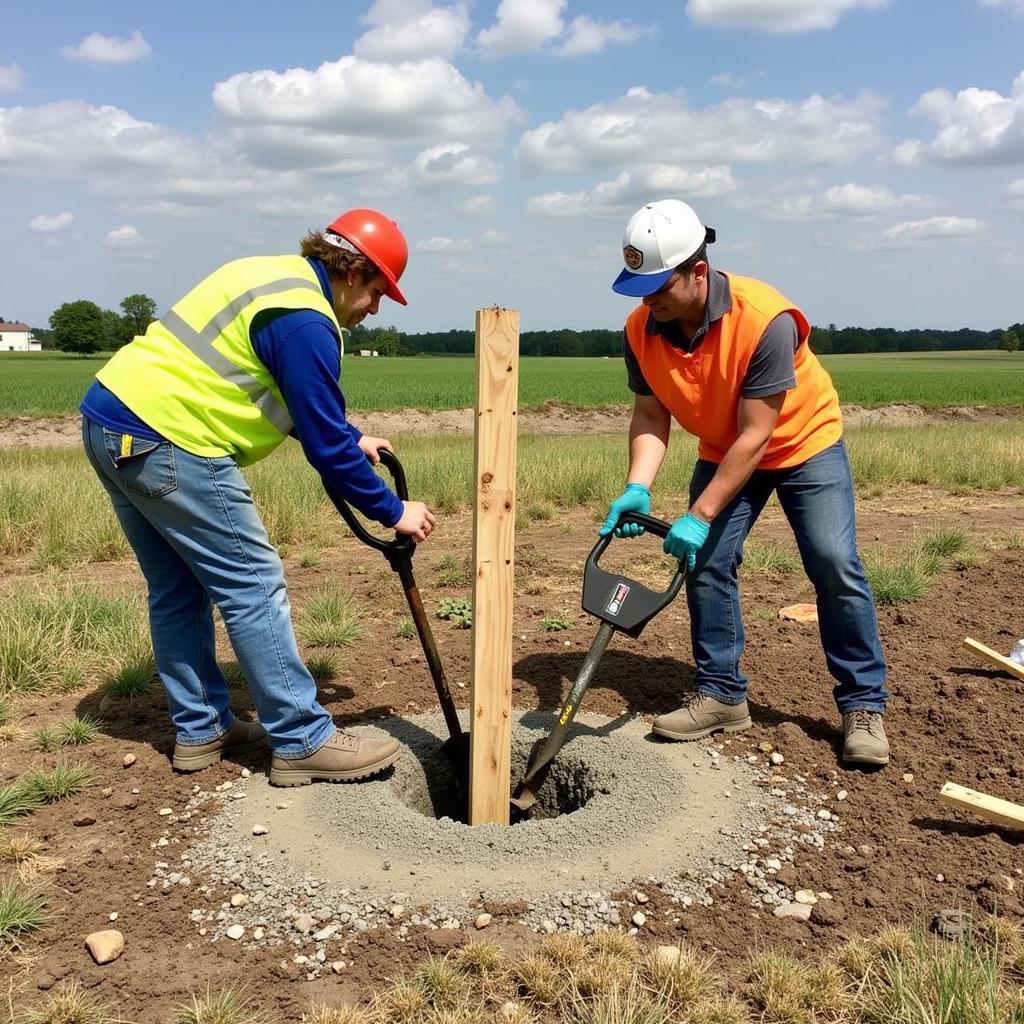A 3 Rail Horse Fence offers a classic and functional solution for containing your equine companions. It’s a popular choice for horse owners due to its balance of visibility, affordability, and strength. This guide will delve into the world of 3 rail horse fencing, exploring its benefits, construction considerations, and maintenance tips.
Choosing the right fencing for your horses is paramount for their safety and well-being. A well-built 3 rail horse fence provides a secure enclosure while allowing horses to see their surroundings, reducing the risk of injury from running into the fence. It also offers a clean, aesthetically pleasing look that complements any property. For those considering horse boarding in Aiken SC, understanding fencing options is crucial.
Understanding the Benefits of a 3 Rail Horse Fence
The simplicity of a 3 rail horse fence is a major advantage. Its straightforward design makes it relatively easy to install and maintain compared to more complex fencing systems. The open design promotes good visibility, both for the horses contained within and for anyone observing from the outside. This can be particularly important in pastures where horses might be startled by unseen objects or animals.
Another key benefit is affordability. Compared to other types of horse fencing like vinyl or composite, 3 rail wood fencing is generally more budget-friendly. This allows horse owners to enclose larger areas without breaking the bank.
Key Advantages of a 3 Rail System:
- Visibility: Horses can easily see the fence, minimizing the chances of collision.
- Affordability: A cost-effective solution for larger properties.
- Simplicity: Easy installation and upkeep.
- Classic aesthetic: Complements various landscape styles.
After this section, you might also want to learn more about horse campgrounds for sale if you’re looking for a larger property for your horses.
Building a Secure and Durable 3 Rail Horse Fence
Proper construction is essential for ensuring the effectiveness and longevity of your 3 rail horse fence. Choosing the right materials is the first step. Pressure-treated lumber is recommended for its resistance to rot and insect damage. Posts should be sturdy and deeply set to provide adequate support for the rails. Spacing between posts should be consistent and appropriate for the terrain.
Choosing the Right Wood:
- Pressure-treated pine: Offers good durability and affordability.
- Hardwoods like oak or cedar: Provide superior strength and longevity but are more expensive.
Post Spacing and Depth:
- Post spacing: Typically 8-12 feet apart, depending on terrain.
- Post depth: At least 2-3 feet deep, set in concrete for maximum stability.
Knowing the best breed of horse for show jumping can also inform your fencing choices as different breeds have different temperaments and jumping abilities.
 Workers installing wooden posts for a 3-rail horse fence
Workers installing wooden posts for a 3-rail horse fence
Maintaining Your 3 Rail Horse Fence
Regular maintenance is crucial for prolonging the life of your 3 rail horse fence. Inspect the fence regularly for signs of damage, such as rot, loose boards, or broken rails. Repair or replace any damaged components promptly to prevent further deterioration and maintain the integrity of the fence. Applying a weather-resistant sealant every few years can help protect the wood from the elements.
Maintenance Tips for Longevity:
- Regular inspections: Check for damage monthly.
- Prompt repairs: Replace broken rails or posts immediately.
- Weather sealant: Apply every 2-3 years for added protection.
- Clear vegetation: Keep grass and weeds away from the fence line to prevent rot.
“Regular maintenance is key to the longevity of any fence, especially wooden ones exposed to the elements,” says John Miller, an experienced horse farm manager. “Catching small issues early can save you significant time and money in the long run.”
You can find more information on specific fencing materials, like the Michael Miller horse panel, on our website.
Conclusion
A 3 rail horse fence remains a popular and practical choice for containing horses. Its balance of affordability, visibility, and ease of maintenance makes it an attractive option for many horse owners. By following the guidelines outlined in this guide, you can ensure a safe and secure environment for your horses while adding a touch of classic charm to your property. Consider the 3 rail horse fence for its practical benefits and timeless appeal. Check out our article on the bascule horse for more information about horse movement and safety.
FAQ
- What is the typical height of a 3 rail horse fence? Around 4-5 feet.
- What type of wood is best for a 3 rail horse fence? Pressure-treated pine or hardwoods like oak or cedar.
- How far apart should the posts be spaced? Generally, 8-12 feet.
- How deep should the fence posts be set? At least 2-3 feet deep, set in concrete.
- How do I maintain a 3 rail horse fence? Regular inspections, prompt repairs, and applying weather sealant.
- Is a 3 rail fence suitable for all breeds of horses? While generally suitable, consider the temperament and jumping ability of your horses.
- What are the alternatives to a 3 rail horse fence? Vinyl, composite, and electric fencing.
Common scenarios with 3 rail fences:
- Horses leaning or rubbing against the fence: Reinforce weak points and provide scratching posts.
- Fence damage from weather: Use high-quality wood and apply weather sealant regularly.
- Horses attempting to jump the fence: Increase fence height if necessary and address any underlying causes of escape attempts.
Related Resources
Check out these related articles for more helpful information:
- Horse boarding options
- Fencing materials comparison
Need assistance with your horse fencing needs? Contact us!
Phone: 0772127271
Email: [email protected]
Address: QGM2+WX2, Vị Trung, Vị Thuỷ, Hậu Giang, Việt Nam
Our customer care team is available 24/7.